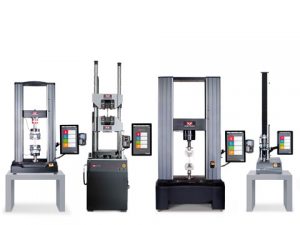Point of FRP design using a material testing machine
I would like to write regarding the point of the FRP product design using a material testing machine by today's column.
As well as the designer who makes the FRP product, it may provide the useful information for people who have the chance to talk with the designers.
Further the following "test" means compression and a bend load type test in this column.
Misunderstanding of component test in a FRP product design
When I'm talking with domestic and abroad various FRP designers persons, it was really amazing for me to know that many of them are conducting component test by bending or compression test by using material testing machine.
When I say first from a conclusion, more than 80% of the evaluation doing an component test using a material testing machine are making a mistake.
When with what do you say you're saying making a mistake?
"There is no designing meaning in obtained data or it isn't meaningful."
I intend to say so.
I'm not saying that you're never supposed to do.
There are some items which should be estimated by an component test of course in the FRP product design.
But using a testing machine for component tests makes a mistake in the beginning.
I'd like to consider this part today.
What is a concept of material testing machines?
I'd like to think from the significance of the material testing machine first.
The outward appearance of the testing machine is the following image.

(The image is referred from http://www.instron.us/en-us/products/testing-systems)
As common testing machine manufacturers are shown below.
Instron: http://www.instron.us
Shimadzu: http://www.shimadzu.com/
MTS: http://www.mts.com/en/index.htm
Zwick: https://www.zwick.com/
They're Instron and Shimadzu in famous by domestic FRP industry, aren't they?
I don't have any images that a specific testing machine has significant advantage of its own performance so much.
There is an advantage in the respective companies; Instron controls a design of a jig and Shimadzu, convenience of software, and Zwick, an automation test system.
What is the main purpose of producing material testing machines?
Well, the part it's difficult to reply to which that I'm reforming and lose my vigor may be some ones.
The role of the material testing machine is;
Acquiring mechanical and physical properties by loading to 1 specific axial direction.
It's very important to say this "1 specific axial direction ".
You can image that testing machines are not designed to load by more than one axis.
Therefore a photograph of the testing machines of Instron above-mentioned also show that stiffened frame and the base table is surface plate certainly.
Risk of the shaped part evaluation using the material testing machine
Talk of an component test using a material testing machine was done at the beginning of this column.
It was stated a material testing machine hung the load to 1 specific axial direction, and we could acquire mechanical and physical properties.
We assume that an component test was performed by a material testing machine here.
A thing as an component test is a shaped configuration.
When something in which you have this shape is pressed with a material testing machine, what would happen?
When trying to push shaped component, it'll be in the state which can't be pressed with the shape element straight.
When still I try to push it by force,
Offset load
will be occured.
This offset load makes the data meaningless and also would lead to risks.
I tried to push 1 axially primarily, but offset load will be in the state which can't be pressed with shape origin straight, and we assume still that it's pushed.
An axis core pushes it in the state which slipped, so it'll take the load of the direction of rotation and a so-called moment.
A shaft of a testing machine bends when this load becomes big, or there is also a fear that a testing machine frame warps.
But the worst impact on testing machine would be the serious damage on a load cell before that.
Because load cell is designed precision instrument to measure 1 specific axial load, so it breaks down easily by offset load.
And when being worst, there is a fear that a pushed test piece flies.
When a testing machine operator was in front of the testing machine without protection equipment, I may be injured.
This is the worst situation.
Damage of a testing machine and a load cell, and, above all, danger to a worker.
The condition above is the truth which I have noticed during my consulting to companies.
What can be acquired by component tests by testing machines
When I say, no meaningful data is obtained from a conclusion.
It's because a testing machine besides the test piece and a jig are encumbered with the part of the load that offset load hangs.
In other words, nobody knows the true failure load.
The load direction isn't also a specific axis, so I don't know at all whether it's no loading mode.
The evaluation by CAE can be done only when a stress of each spatial axis is clear even if it does stress evaluation by a Mises stress.
The data without unknown load direction is not useful for CAE.
Some latest software would give us some outputs even though the load information like above, but we should notice that it is NOT basic logic as CAE evaluation process.
The thing important point when we use a material testing machine
The main points are below;
1. Conducting test based on test standard.
2. Test specimen inspection.
3. Calibrating testing machine properly.
I will explain them respectively.
1. Conducting test based on test standard
Test standard is well considered as expected.
You can notice that load direction is thoroughly considered for proper test.
And evaluation and calculation method of obtained data is also told accurately.
Even if it's based on these ideas, it's a principle to test based on the standard first.
Customized component or material test by using testing machine would be necessary in some cases. I should say that the very high skill to design test method, but if avoiding offset load is thought as a fundamental principle, the test would be meaningful.
If you want to conduct component test, the test fixture to make the shaped specimen only to 1 specific load direction.
And it's important to prepare test procedure method to teach the manner to operators.
2. Test specimen inspection.
This is often also left.
Please carry a check of a test specimen inspection.
Geometric tolerance like parallelism or perpendicularity is important in particular.
In other words, test specimens, not satisfied geometric tolerance, would have the possibility to lead to offset load.
If you do material test without inspection regarding test specimens, you give up acquiring the proper material data.
Please carry without exception so that it may be checked to all test specimen inspection.
3. Calibrating testing machine properly.
Load cell shall be calibrated one per year at least.
Further, test machine frame shall be checked once per several years like shaft and the driving part, please repair it rather early.
If you will conduct material test by outsourcing, it would be better to get the testing machine calibration certification copy.
Today I try to write about a material test by using an component test as a base material.
As well as FRP, I think that the most important point would be "faithful to a technological basis". I find evolution of IT, software technology and control technique in recent years, but neither now nor the past change a basic part.
It can be called one of these basic parts to say that we have to do acquisition of mechanical and physical properties while taking the biggest attention to the load direction because FRP is the material with the anisotropy.
The unchanged basis above is important, but I find the part to be forgot more than I imagined.
If you lost the direction in something, you should be very much obliged to get back to the basic without exception.



